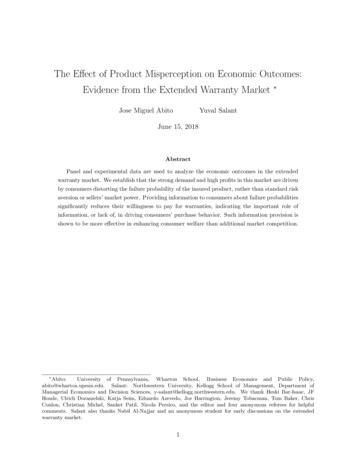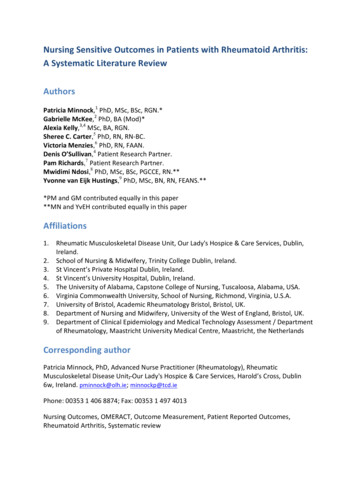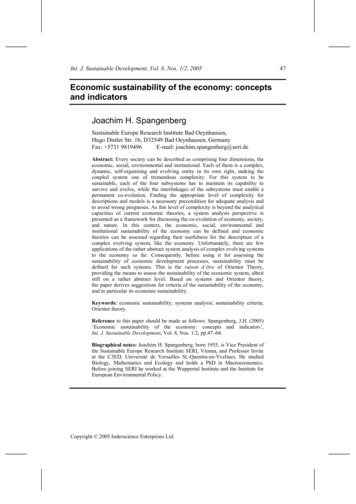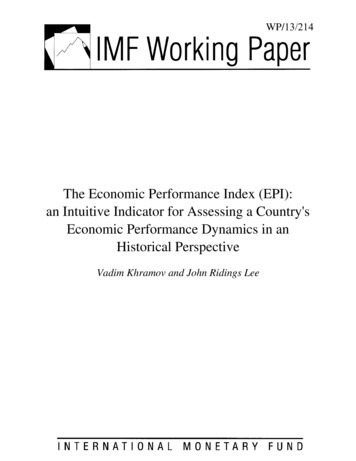
Transcription
The Effect of Product Misperception on Economic Outcomes:Evidence from the Extended Warranty MarketJose Miguel Abito Yuval SalantJune 15, 2018AbstractPanel and experimental data are used to analyze the economic outcomes in the extendedwarranty market. We establish that the strong demand and high profits in this market are drivenby consumers distorting the failure probability of the insured product, rather than standard riskaversion or sellers’ market power. Providing information to consumers about failure probabilitiessignificantly reduces their willingness to pay for warranties, indicating the important role ofinformation, or lack of, in driving consumers’ purchase behavior. Such information provision isshown to be more effective in enhancing consumer welfare than additional market competition. Abito:University of Pennsylvania, Wharton School, Business Economics and Public Policy,abito@wharton.upenn.edu. Salant: Northwestern University, Kellogg School of Management, Department ofManagerial Economics and Decision Sciences, y-salant@kellogg.northwestern.edu. We thank Heski Bar-Isaac, JFHoude, Ulrich Doraszelski, Katja Seim, Eduardo Azevedo, Joe Harrington, Jeremy Tobacman, Tom Baker, ChrisConlon, Christian Michel, Sanket Patil, Nicola Persico, and the editor and four anonymous referees for helpfulcomments. Salant also thanks Nabil Al-Najjar and an anonymous student for early discussions on the extendedwarranty market.1
1IntroductionAn extended warranty is an insurance contract that protects against the failure of a durable goodsuch as a consumer electronic. The extended warranty market is highly profitable,1 and has caughtthe attention of consumer protection and competition authorities in different countries. In theUK, the Office of Fair Trading observed that “there is insufficient competition and information toensure that consumers get good value” in the extended warranty market, and that “many electricalretailers may make considerable profits on the sale of extended warranties” (UK Competition Commission, 2003). The UK Competition Commission has consequently conducted a comprehensiveinvestigation of this market. Its report expressed concerns about the lack of market competition dueto the way warranties are sold, and the lack of available information at the point of sale about thereliability of the insured product and the cost of repair (UK Competition Commission, 2003). TheFederal Trade Commission in the US has also looked into this market, and is advising consumersto obtain information about the likelihood of product failure and the potential cost of repair beforebuying an extended warranty.2This paper uses panel and experimental data to analyze market competition and consumerbehavior in the extended warranty market. The first takeaway from the analysis is that the strongdemand and high profits in this market are driven by consumers distorting the failure probabilityof the insured product, rather than standard risk aversion or sellers’ market power. The secondtakeaway is that providing information to consumers about failure probabilities significantly reducestheir willingness to pay for warranties, indicating the important role of information, or lack of, indriving consumers’ purchase behavior. The third takeaway is that such information provision ismore effective in enhancing consumer welfare than additional market competition, highlighting therelevance of policies that guide consumers’ decision making directly.The starting point of our analysis is that the market for extended warranties is characterized bymarket power on the supply side and high willingness to pay on the demand side. On the supplyside, sellers have market power because the warranty is an add-on product. It is usually offeredto consumers immediately after they finalize their decision to buy the insured product,3 at a stagein which searching for another product or switching to another seller is costly. This search andswitching cost implies significant market power a là Ellison’s (2005) add-on pricing model.41The UK Competition Commission (2003) estimates that the top five consumer electronics retailers in the UKearned 116 to 152 million pounds annually on the sale of extended warranties in the early 2000s. Similarly, analystsin the US estimate extended warranties accounted for almost half of BestBuy’s operating income in 2003, and thatprofit margins on warranties ranged from 50% to 60% (“The Warranty Windfall,” Business Week (December 19,2004)).2See d-warranties-and-service-contracts (accessed on June15, 2018).3For example, BestBuy trains its sales people to offer warranties to consumers only after they finalize the TV purchase decision.For BestBuy’s presentation of selling skills, seehttps://www.extendingthereach.com/wps/PA VCorationFramework/resource?argumentRef static&resourceRef /files/Best Buy Vendor Selling Skills.pdf(accessed on June 15, 2018).4According to the UK Competition Commission (2003), “Most customers shop around for electronic goods; theretail price is a major factor in their choice. However, extended warranty buyers do not often plan to buy an extended2
On the demand side, about one in four TV buyers in our panel data purchases an extendedwarranty. On average, this buyer pays 90 or more to insure against a loss of at most 400 with7% probability. What drives this high willingness to pay? Sydnor (2010) uses data on homeinsurance deductible choices to show standard risk aversion in the form of diminishing marginalutility for wealth cannot explain consumers’ high willingness to pay for reductions in deductibles.Sydnor (2010) proposes several alternative explanations for the high willingness to pay, includingmisperception of claim probabilities and reference-dependent preferences. Barseghyan et al. (2013)examine several alternatives to standard risk aversion, and conclude that upward distortion of claimprobabilities plays a key role in explaining deductible choices in home and auto insurance.Our first objective is to quantify the importance of probability distortions and standard riskaversion on the demand side relative to market power on the supply side in determining demand,prices, and profits in the extended warranty market.To do so, we consider a model of market competition based on Ellison’s (2005) add-on pricinggame to which we incorporate Barseghyan et al.’s (2013) decision-making model, in which consumersare assumed to be risk-averse expected utility maximizers who may distort failure probabilities. Wethen use panel data on household-level product and extended warranty purchases from a large USelectronics retailer to estimate consumers’ risk-aversion and probability-distortion parameters andthe retailer’s cost of selling and servicing the warranty. The panel data documents approximately45,000 transactions made by almost 20,000 households between 1998 and 2004. Almost 30% ofthe transactions involved the purchase of an extended warranty. Our structural estimation focuseson TVs, which constitute about 11% of the data, due to the availability of TV failure rates fromConsumer Reports.Variation in repair costs for different products with the same failure rate enables us to separately identify the risk-aversion and probability-distortion parameters. Intuitively, either parametercan explain the willingness to pay for a warranty to any given product. But they have differentpredictions regarding the rate at which willingness to pay changes in response to a change in therepair cost. In particular, probability distortion implies a slower rate than risk aversion. Thus,fixing the failure rate, changes in willingness to pay in response to changes in repair costs enableus to separately identify the two parameters.Our estimation indicates there is a substantial upward distortion of failure probabilities. Forexample, a 5% objective failure probability is perceived as a 13% failure probability. This estimateis similar to the estimate of Barseghyan et al. (2013) and to results from our experiment describedbelow. Standard risk aversion, on the other hand, plays an insignificant role in consumers’ decisionmaking. The estimated risk-aversion parameter implies willingness to pay is close to actuariallyfair rates in the absence of probability distortion.We use counterfactual analysis to quantify the effect of probability distortions on market outwarranty (less than half of consumers who bought an extended warranty said that they had planned to do so beforethey went into the store), and many are unaware of the existence of alternatives to taking the EW offered at thepoint of sale.”3
comes. Specifically, we compare outcomes in the existing market with outcomes in a counterfactualmarket in which retailers have the same market power but the distortion is “shut down” in thesense that consumers use objective failure probabilities in decision making. A key assumption inthe analysis is that TVs are priced similarly whether consumers distort failure probabilities or not.As discussed in section 7, this assumption is supported by comparing TV prices between retailerswho offer extended warranties and retailers who do not, institutional details, and Ellison’s (2005)results.The counterfactual analysis demonstrates that probability distortions drive the strong demandand high profits, whereas market power drives the high prices and margins. Specifically, whenshutting down probability distortions, volume and profit decrease by more than 90%, but price andmargin decrease by only 4% and 11%, respectively.Our second objective is to better understand the mechanism for the distortion. One possiblemechanism is that consumers know the objective probabilities but overweigh them as predicted byProspect Theory (Kahneman and Tversky (1979)). Another possible mechanism — which seems tofit the concerns of competition authorities — is that consumers lack information about the objectiveprobabilities and overestimate them. Bordalo et al.’s (2015) theory of attention proposes a possiblereason for overestimation: consumers are surprised when reminded by the sales person that TVscan break, and overreact to this information.5Understanding the mechanism is welfare- and policy-relevant. If the distortion stems from lackof information about failure probabilities, as postulated by the second mechanism, consumer welfareshould be evaluated with respect to the objective probabilities, and room exists for policies thatinform consumers about these probabilities. On the other hand, if consumers know the probabilitiesand distort them in their decision making, deciding whether objective or distorted probabilitiesshould be used in welfare analysis depends on whether one interprets overweighting as a deliberateprocess or as a mistake in decision making.6To study the mechanism, we conducted experiments. In a pretest with approximately 500participants, we found the failure rate in the pool of participants was about 5%. This rate issimilar to the failure rates reported by Consumer Reports.In the first main experiment with approximately 1,000 participants who did not participate inthe pretest, we randomly assigned participants to one of three treatments. In two treatments, weelicited participants’ perceived TV failure probability and their willingness to pay for an extendedwarranty, and in the third, we first informed participants about the objective probability and thenelicited their willingness to pay. We found that average perceived TV failure probability among5Possible support for Bordalo et al.’s (2015) theory comes from the comparison of the strong in-store demand withthe weak online demand in the data (see section 2.3.) Indeed, making TV failures salient and triggering overreactionseems harder in the online marketplace than in the store, where the sales person has the buyer’s attention, and canpress the buyer to make a quick decision.6This mechanism-based approach to welfare analysis is based on Rubinstein and Salant (2008, 2012) who arguebehavioral welfare analysis should rely on understanding the mechanism that maps the decision maker’s preferencesto his choices.4
uninformed participants was about 14%, which is almost three times larger than the objective failure rate. Moreover, the average willingness to pay among informed participants was much lowerthan among uninformed participants. For example, the median willingness to pay among informedparticipants was about half of the median willingness to pay among uninformed participants. Weinterpret these findings as suggesting that lack of information about failure probabilities is a relevant factor in creating the distortion, and that information provision reduces willingness to paysignificantly.In the second experiment with another 900 participants, we examined whether traces of probability distortion were present among informed participants. Specifically, we elicited informedparticipants’ willingness to pay for TVs with the same failure rate but with different repair costs,and used the identification strategy of the empirical analysis to separately identify the risk aversionand probability distortion parameters from the reported willingness to pay. We found that mostparticipants displayed modest or no probability distortion as well as no risk aversion. We interpretthese findings as indicating information provision reduces the distortion significantly.Equipped with the experimental findings, our third objective is to evaluate consumer welfareand the effectiveness of various policy interventions based on the panel data. We first observe thatwelfare in the existing market is negative, i.e., consumer welfare would increase if the market forwarranties did not exist. This is because any positive welfare generated by warranty purchasesof buyers with true willingness to pay above price is dominated by the decrease in welfare dueto warranty purchases of buyers with true willingness to pay below price who overestimate failureprobabilities.As for policy, Armstrong (2008) discusses two broad categories of policies competition authorities use to enhance market performance and consumer welfare. The first and more prominentcategory includes competition policies, which target the supply side of the market and aim to intensify competition. The second category includes consumer policies, which target the demand sideand aim to enhance consumers’ decision making directly.An example of a competition policy in the extended warranty market is the UK CompetitionCommission’s (2003) proposal that retailers advertise and post the price of the warranty alongsidethe price of the product it insures. This policy is expected to drive down prices because it reducesthe search and switching costs of consumers. If the demand for warranties were driven solely byconsumers’ risk aversion, such a price reduction would have a positive effect on consumer welfare.It would increase the utility of existing warranty buyers as well as the utility of new buyers, whonow purchase the warranty because of the lower prices. But with overestimation, the utility of newbuyers may be negative, and so the effect of price reduction on consumer welfare is unclear. On theother hand, a consumer policy that reduces overestimation increases consumer welfare, assumingno price change, because consumers make better choices, but may trigger a price change, and soits effect is also unclear. An example of a consumer policy is to demand retailers to disclose failureprobabilities to consumers, similar to what we did in the experiment.5
Counterfactual analysis demonstrates that consumer policies that reduce overestimation aremore effective in enhancing consumer welfare than competition policies that lead to price reduction.Intuitively, when warranty prices go down but overestimation still exists, consumer welfare decreasesbecause the welfare gain due to lower prices is dominated by the welfare loss generated by moreconsumers buying warranties due to overestimation. On the other hand, when overestimation goesdown, consumer welfare increases because the welfare gain due to consumers making better choicesdominates any other effect. Thus, our findings indicate competition policies may lead to suboptimalresults in markets with uninformed or biased consumers relative to consumer policies that aim toimprove consumers’ decision making directly.The rest of the paper is organized as follows. Section 1.1 reviews the related literature. Section 2presents the panel data and reports empirical regularities on household purchase behavior. Section 3presents the model and the identification strategy. Section 4 describes the estimation procedure.Section 5 reports the results of the estimation. Section 6 studies the mechanism for the distortion.Section 7 studies the importance of probability distortions relative to market power in determiningdemand, prices, profit, and consumer welfare. Section 8 concludes with a discussion of policyimplications.1.1Related literatureThis paper is related to the empirical literature on estimating risk preferences (see Barseghyanet al. (forthcoming) for a recent survey.) Cohen and Einav (2007) use data on auto insurancedeductible choices to estimate a structural model of individual choice with standard risk aversion.They find unobserved heterogeneity in risk aversion is greater than unobserved heterogeneity inrisk (claim rates), and that the two are positively correlated. Barseghyan et al. (2011) comparehouseholds’ degree of standard risk aversion in auto and home insurance. They find risk preferencesare not stable across contexts, and that many households exhibit greater risk aversion in their homedeductible choices than in their auto deductible choices.Sydnor (2010) uses home insurance deductible choices to demonstrate that consumers’ willingness to pay for insurance is very high. For example, many consumers pay 100 to lower theirdeductible from 1,000 to 500 when their (ex-post) claim rate is less than 5%. Sydnor (2010)shows that fitting such choices to a model with standard risk aversion yields extreme levels of riskaversion, and proposes several alternative explanations for the high willingness to pay, includingmisperception of claim rates and reference-dependent preferences.Our paper is closest to Barseghyan et al. (2013), who develop a structural model of individual choice with standard risk aversion and probability distortions, and estimate it using data onauto and home insurance deductible choices. Barseghyan et al. (2013) find upward distortionof claim probabilities plays a key role in explaining deductible choices. Moreover, the shape ofthe probability-distortion function fits the shape predicted by Prospect Theory (Kahneman andTversky (1979)). Several other papers incorporate probability distortions to the estimation of risk6
preferences, and find evidence of their relevance in various contexts, including financial markets(Kliger and Levy (2009)) and betting markets (Jullien and Salanié (2000), Snowberg and Wolfers(2010), Chiappori et al. (2012), Gandhi and Serrano-Padial (2014)).We make three contributions to this literature. First, we quantify the effect of probabilitydistortions, relative to market power and risk aversion, on prices, volume, and profit. We are ableto make progress on this question because electronics retailers have (1) monopolistic power whenselling warranties, which facilitates cost estimation, and (2) little flexibility in cutting TV pricesbelow cost, which facilitates the counterfactual analysis. Second, we use experimental data toshow the distortion stems from lack of information about failure probabilities. This contribution isimportant for welfare analysis and the evaluation of policy interventions. Third, we demonstratethat consumer policies are more effective than competition policies in improving consumer welfare.Another related literature is the marketing and experimental literature on why consumers buyextended warranties (Chen et al. (2009), Huysentruyt and Read (2010), Jindal (2014)). Chen etal. (2009) use purchase data of about 600 households from an unspecified US electronics retailerover the period November 2003 to October 2004 to study how the insured product characteristics(hedonic vs. utilitarian) and marketing actions by retailers affect the likelihood of purchasing anextended warranty. Huysentruyt and Read (2010) use survey data to demonstrate that participantsoverestimate the likelihood of washing-machine breakdowns and their cost of repair. Jindal (2014)uses different survey data to highlight the role of loss aversion in the context of extended warrantiesfor washing machines. The four-year failure probability of washing machines is 20% to 30%, soprobability distortions are expected to have a less significant role in this context. We contributeto this literature by demonstrating that lack of information about failure probabilities is a relevantfactor in creating the distortion, and that information provision significantly reduces the distortion.2DataThis section describes the panel data.We use the INFORMS Society of Marketing Science Durables Dataset 1, which is a panel data ofhousehold durable-goods transactions from a major US electronics retailer. The full sample containsapproximately 140,000 product-level transactions made by almost 20,000 households across theretailer’s 1,176 outlets and its online store. Prices across outlets and the online store are essentiallyidentical. Transactions took place between December 1998 and November 2004.The data contains four main types of transactions. About 117,000 transactions involve thepurchase of a specific product other than an extended warranty. About 15,000 transactions involvethe purchase of an extended warranty. About 5,000 transactions involve the return of a productother than an extended warranty, and about 1,000 transactions involve the return of an extendedwarranty. For each transaction, we observe the product ID, the price of the product, the brand,and the category and subcategory of the product.7
A shopping trip is a collection of transactions made by a given household at a given store ata given date and time. For each household and shopping trip, we observe the buyer’s gender, theage and gender of the head of the household, income group7 , and whether there are children in thehousehold.There are three data issues that we have to deal with. First, the data only tells us the productsubcategory (e.g., 9-16 inch TVs) the warranty is for. We restrict our sample to shopping trips inwhich a one-to-one mapping exists between the extended warranty and the corresponding product.For example, we drop shopping trips involving a purchase of two 9-16 inch TVs but only oneextended warranty purchased for this subcategory. We lose approximately 2,000 observations forthis reason.Second, if a household did not purchase an extended warranty for a given product, we do notobserve the warranty’s price. To identify the warranty price in such cases, we match the nonwarranty transaction with a corresponding warranty transaction for the same product ID from theclosest transaction date. After dropping transactions for which we cannot find a correspondingwarranty transaction, we end up with a sample of approximately 45,000 observations.8Third, for the structural estimation, we need information about the insured product failureprobability, which is the likelihood that the product will need a repair within three to four yearsof purchase. We focus on TVs in the estimation, because we are able to obtain TV failure ratesfrom Consumer Reports, which publishes TV failure rates by brand and size every year based onsurveys of tens of thousands of TV owners. We use the failure rates from the 2004 report, which isbased on the responses of more than 100,000 TV owners between 1998 and 2002.2.1Attachment rates, prices, and approximate profit marginsTable 1 shows the fraction of consumers who bought extended warranties (henceforth, the attachment rate) and the extended-warranty-to-product price ratio for each product category. Attachmentrates range from about 20% for items such as VCRs (VIDEO HDWR), music CDs, and video games(MUSIC), to as high as 40% for items such as car stereos and speakers (MOBILE). Warranties arepriced on average at 24% of the price of the insured product, and the standard deviation of thewarranty-to-product price ratio is 11% (see Panel A in Figure 1 for the distribution of ratios.)No significant correlation at the product level exists between variations in the product price andvariations in the warranty price.9Table 2 reports TV attachment rates, prices, warranty-to-product price ratios, and failure ratesbroken down by TV subcategory. Attachment rates range from 15% to 35%, with higher attachment7Income group is a number from 1 to 9, where 9 is the highest income group. We do not have additional informationon income within each group.8We also drop the less than 1,000 observations in which the price of the good is significantly less than the price ofthe warranty.9We regress the log of the product price on the log of the warranty price for each product, and estimate an averagecoefficient equal to 0.046 with an average p-value of 0.26.8
Table 1: Attachment rate and price ratio by product categoryAUDIODVSIMAGINGMAJORSMOBILEMUSICP*S*TPC HDWRTELEVISIONVIDEO HDWRWIRELESSOVERALLAttachment .2060.2450.287EW-Product price 3075828148544277Notes: Overall attachment rates and EW-Product price ratios are salesweighted averages.9-16in19-20in25in27in 30inOVERALL (TV)Table 2: EW information for TVsAttach rate TV price EW-TV price ratio Fail 30.6810.6190.672Obs4221067522147712294717Notes: Fail rates are from Consumer Reports. Overall numbers are sales-weighted averages. Margin is computed as(EW price - fail rate TV price)/EW price.rates for more expensive categories. The average price ratio for TVs is about 22% with a standarddeviation of 8% (see Panel B in Figure 1.)Using the TV price multiplied by the TV failure rate as a rough estimate of the expected costof servicing a TV warranty, Table 2 also reports a “back of the envelope” profit margin on TVwarranties. This margin ranges from 62% to 73% for different TV subcategories, which is close towhat is cited in the popular press. We expect the seller in our dataset to have lower margins dueto revenue sharing with warranty providers and commissions to sales people.2.2Buyers’ characteristicsTables 3 and 4 examine the relationship between attachment rates and buyers’ characteristics forall product categories and for TVs. In Table 3, attachment rates are broken down by buyer gender,gender and age of the head of the household, income, and whether there is a child in the household.Income is the only characteristic that is strongly correlated with attachment rates for TVs andall other product categories. For example, when moving from the highest to the lowest incomecategory, TV attachment rates increase by almost 11 percentage points in TV attachment rates.Having a child seems to decrease TV attachment rates by 7 percentage points, but this effect goes9
Table 3: Attachment rates by buyer and household characteristicsAllTVCharacteristicAttach rate Obs Attach rateFemale0.305139760.286Male0.280262280.261Female (head of hh)0.308124120.285Male (head of hh)0.280247600.260Below median income (category 5)0.321104040.310Above median income (category 5)0.276339000.253Lowest income category (category 1)0.34326560.340Highest income category (category 9)0.25364520.233Over 50 (head of hh)0.293232590.282Under 50 (head of hh)0.280208820.250Has child in hh0.282139400.248No child in 71719751279779Table 4: Regression of EW purchase dummy on buyer and household characteristicsDependent variable: EW purchase dummyAllTVCoeffSECoeffSEMale-0.064(0.039) -0.069(0.101)(0.0004) 0.001(0.001)Age (head)0.001 Income-0.014 (0.003) -0.013 (0.007)(0.014) -0.017(0.038)Has child in hh 10 5Male Age0.001(0.001) 0.001(0.001)Male Income0.002(0.003) 10 4 (0.009)Male Child0.004(0.017) -0.006(0.045)Adjusted R20.080.06No. obs (good-hh-trip) 193751973Notes: Both regressions include brand and subcategory fixed effects.Standard errors in parentheses are clustered at shopping-trip level.Significance levels: ***1%, **5%, *10%.away once we introduce controls in a regression analysis.Table 4 presents the results of regressing an extended warranty purchase dummy on buyers’and households’ characteristics and their interactions with gender. The regressions include brandand subcategory fixed effects to account for average differences in purchasing behavior across thesedimensions. Consistent with most of the raw means in Table 3, the only characteristic that is statistically and economically significant is income when all product categories are included. AdjustedR2 ’s are very small despite including subcategory and brand fixed effects. All in all, the two tablesindicate that other than income, the above characteristics are not strongly correlated with warrantypurchases.10
Table 5: Regression of extended warranty purchase dummy on shopping modeDependent variable: EW purchase dummyIIIIIIIVVIn-store?0.247*** 0.200*** 0.180*** 0.175*** ld FENYYYYSubcategory FE NNYYYBrand FENNNYYMonth FENNNNYYear FENNNNYNo. obs4430444304443044430444304(good-hh-trip)No. HHs1715817158171581715817158Notes: Standard errors in parentheses are clustered at shopping-trip level.2.3In-store versus online transactionsAbout 1% of the transactions in the data were made online. The attachment rate for these transactions is about 4%, which is one seventh of the in
Consumer Reports. Variation in repair costs for different products with the same failure rate enables us to sepa-rately identify the risk-aversion and probability-distortion parameters. Intuitively, either parameter can explain the willingness to pay fo





![project2 Encase.pptx [Read-Only]](/img/12/project2-encase.jpg)




